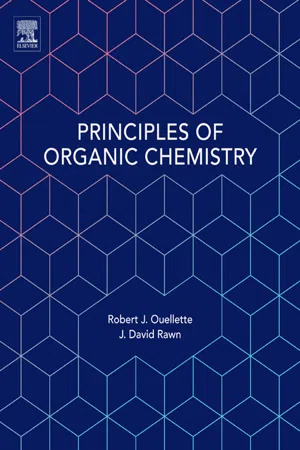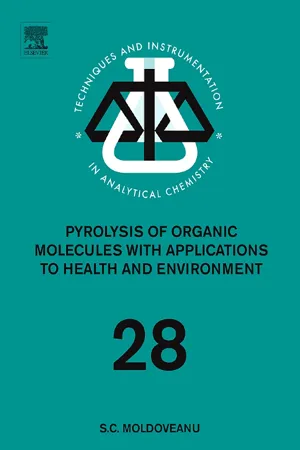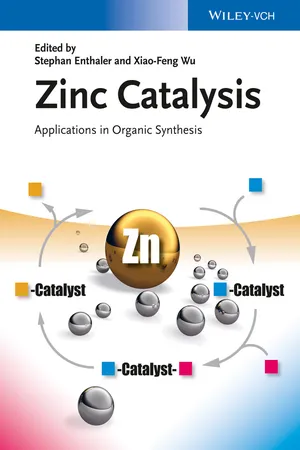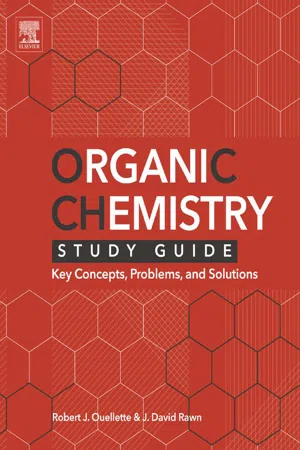Chemistry
Chemical Reactions of Amines
Amines undergo various chemical reactions, including nucleophilic substitution, acylation, and oxidation. In nucleophilic substitution, amines can displace a leaving group from an alkyl halide. Amines can also undergo acylation to form amides, and oxidation to form amine oxides or nitroso compounds. These reactions are important in organic synthesis and the production of pharmaceuticals and other chemicals.
Written by Perlego with AI-assistance
Related key terms
4 Key excerpts on "Chemical Reactions of Amines"
- eBook - ePub
- Robert J. Ouellette, J. David Rawn(Authors)
- 2015(Publication Date)
- Elsevier(Publisher)
We described some reactions of amines in earlier chapters. These reactions occur because the nonbonding electron pair of the nitrogen atom makes amines nucleophilic. We will review each type of reaction in this section.Reactions of Amines with Carbonyl Compounds
In Chapter 10 , we described the addition-elimination reaction of amines with carbonyl compounds. An amine adds to the carbonyl carbon atom to give a tetrahedral intermediate. This product is unstable, and it loses water to form an imine. In general, imines are less stable than carbonyl compounds. Thus, the reaction is favorable only if water is removed from the reaction mixture. Most imines are not stable; they rapidly hydrolyze in aqueous solution to give carbonyl compounds.Reactions of Amines with Acyl Halides
In Chapter 11 , we noted that an amide can be made by treating an amine with an acid halide. We recall that acid halides are very reactive acyl derivatives of acids; amides are very stable.Only ammonia and primary or secondary amines form amides. That is why pyridine, which cannot form an amide, is often used as a base to react with the HCl formed in the reaction.Reactions of Amines with Alkyl Halides
We described nucleophilic substitution reactions of alkyl halides in Chapter 7 . Primary and secondary alkyl halides react with nucleophiles by an SN 2 mechanism. Amines are nucleophiles that can displace a halide ion from a primary or secondary alkyl halide to form an ammonium halide salt that is subsequently neutralized.The initial product of the nucleophilic substitution reaction is a secondary ammonium ion. It can lose a proton in an equilibrium reaction with the reactant primary amine. The secondary amine then can continue to react with the alkyl halide to give a tertiary amine and eventually a quaternary ammonium ion.Quaternary ammonium salts are ammonium salts that have four alkyl or aryl groups bonded to a nitrogen atom. Some quaternary ammonium salts containing a long carbon chain are invert soaps.Invert soaps differ from soaps and detergents because the polar end of the ion in the micelle is positive rather than negative. Like soaps, the long hydrocarbon tail associates with nonpolar substances, and the polar head dissolves in water. Invert soaps are widely used in hospitals. They are active against bacteria, fungi, and protozoa, but they are not effective against spore-forming microorganisms. Benzalkonium chlorides are one type of invert soap. The alkyl groups of these compounds contain from 8 to 16 carbon atoms. - eBook - ePub
Pyrolysis of Organic Molecules
Applications to Health and Environmental Issues
- Serban C. Moldoveanu(Author)
- 2009(Publication Date)
- Elsevier Science(Publisher)
hapter 13 Pyrolysis of Amines and IminesS.C. Moldoveanu
13.1. Primary amines
General aspects
Primary amines can be considered as compounds derived from ammonia by the substitution of a hydrogen atom with an organic radical alkyl or aryl, or as compounds resulting from the substitution of a hydrogen atom from an organic molecule with the group NH2 . The general formula of primary amines is R–NH2 (for aromatic primary amines the formula Ar–NH2 is sometimes used). Continuing the substitution of hydrogens from ammonia with alkyl or aryl organic radicals, secondary amines (R2 NH) and tertiary amines (R3 N) are generated. The formation of quaternary ammonium cations ( ) is also possible, these compounds being the equivalent of ion having the hydrogen substituted with organic radicals. The amines are named either using the name of the organic radical with the suffix amine (e.g., methylamine for CH3 –NH2 ) or using the prefix amino followed by the name of the hydrocarbon (e.g., aminomethane for CH3 –NH2 ). The substitution of a hydrogen from ammonia with an acyl radical (R–C(O)–) leads to the formation of amides. Amides can be considered derivatives of acids, and their pyrolysis is discussed in Chapter 20. Amine oxides can also be considered compounds different from amines and are discussed in Section 14.4.Aliphatic primary amines
Aliphatic primary amines have a carbon with sp3 hybridization and two hydrogen atoms connected to the nitrogen atom. Pyrolysis of these compounds can take place with the involvement of the NH2 group. In this case, there are two common paths, one with ammonia elimination and formation of an unsaturated hydrocarbon (similar to water elimination in alcohols) and the other with hydrogen elimination and formation of a nitrile. These two types of reactions are shown below:(13.1.1) (13.1.2) Other reactions involving the amino group were also noticed during pyrolysis of some amines, such as generation of HCN, N2 - eBook - ePub
Zinc Catalysis
Applications in Organic Synthesis
- Stephan Enthaler, Xiao-Feng Wu, Stephan Enthaler, Xiao-Feng Wu(Authors)
- 2015(Publication Date)
- Wiley-VCH(Publisher)
5 Zinc-Catalyzed Hydroamination ReactionsTianshu Li, Jelena Wiecko and Peter W. Roesky5.1 Introduction
Nitrogen-containing molecules, such as amines, enamines, and imines, have played important roles in the production of pharmaceuticals, synthetic products, and fine chemicals [1]. Many classical synthetic pathways to these molecules contain multistep reactions and produce side products and large amounts of chemical waste. The hydroamination reaction involves C–N bond formation by the direct addition of an organic amine N–H bond across the unsaturated carbon–carbon bond of an alkene, allene, or alkyne. Compared to the classic routes, hydroamination is a straightforward synthetic approach and a highly atom-economic method to prepare substituted and/or cyclic amines (Scheme 5.1 ). Although hydroamination reaction is thermodynamically feasible, the high reaction barrier is a significant problem in its practical use. The hydroamination of alkenes is more difficult than that of alkynes due to the lower reactivity and electron density of C=C bonds [2]. Intramolecular hydroamination results in nitrogen-containing heterocyclic products, as illustrated in Scheme 5.1 for the hydroamination–cyclization of an aminoalkene or aminoalkyne substrate with gem-dialkyl substituents [3].General reaction for intramolecular hydroamination–cyclizations. (a) Hydroamination of olefins. (b) Hydroamination of alkynes.Scheme 5.1The intermolecular hydroamination reaction of an amine with an unsymmetrical alkene or alkyne followed by tautomerization can lead to either the Markovnikov or the anti-Markovnikov product (Scheme 5.2 ).General reaction for intermolecular hydroaminations. (a) Hydroamination of olefins. (b) Hydroamination of alkynes.Scheme 5.2An important area of research is the development of catalysts that prefer to form one of the two possible products selectively. The catalytic anti - eBook - ePub
Organic Chemistry Study Guide
Key Concepts, Problems, and Solutions
- Robert J. Ouellette, J. David Rawn(Authors)
- 2014(Publication Date)
- Elsevier(Publisher)
Nitriles are reduced to primary amines using lithium aluminum hydride. The nitrile can be made by displacement of a halide ion from a haloalkane by cyanide ion. This method allows the formation of primary amines having one additional carbon atom.Reduction of amides using lithium aluminum hydride is the most versatile way of producing amines. Amides are easily prepared by reaction of an acyl chloride and an amine. However, the reaction is most versatile because primary, secondary, and tertiary amines can be synthesized using primary, secondary, and tertiary amides, respectively. Reduction of nitroaromatic compounds is used to produce anilines. Tin and HCl is the usual reducing agent.23.9 Hofmann Rearrangement
The Hofmann rearrangement occurs when a primary amide reacts with a basic solution of a halogen such as chlorine or bromine. In this process, the carboxyl carbon atom is lost as carbonate ion and a primary amine results. The rearrangement occurs when an alkyl group is transferred from the carboxyl carbon atom to the nitrogen atom in one of the several intermediates involved in the reaction mechanism. The rearrangement occurs with retention of configuration of the alkyl group.23.10 Conjugate Addition Reactions
The reactions of amines are distinctly different than the reactions of alcohols. Amines are substantially stronger bases than alcohols. Amines are sufficiently basic to exist to some degree as the conjugate acid in water. Alcohols require strong acids to form the conjugate acid. Amines are much less acidic than alcohols—the pK a values of amines and alcohols are 35 and 16, respectively.Within a period of the periodic table, the nucleophilicity decreases from left to right for the elements in compounds of similar structure. Ammonia is a distinctly better nucleophile than water because nitrogen is less electronegative (EN 3.0) than oxygen (EN 3.5). Likewise, amines are better nucleophiles than alcohols. Usually, it is necessary to convert an alcohol to its alkoxide ion to make it sufficiently nucleophilic to displace a leaving group such as a halide ion from a haloalkane. The neutral amine is sufficiently nucleophilic for this type of displacement reaction.
Index pages curate the most relevant extracts from our library of academic textbooks. They’ve been created using an in-house natural language model (NLM), each adding context and meaning to key research topics.



